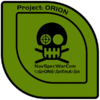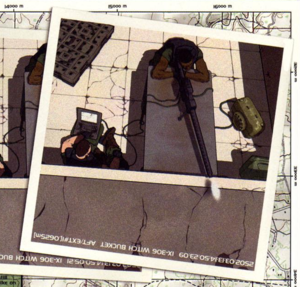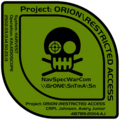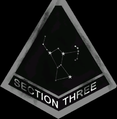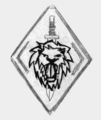ORION Project: Difference between revisions
From Halopedia, the Halo wiki
Covenant PhD (talk | contribs) Tag: Undo |
m (→The relaunch of ORION: Link clear up) |
||
| Line 43: | Line 43: | ||
===Phase 2=== | ===Phase 2=== | ||
====The relaunch of ORION==== | ====The relaunch of ORION==== | ||
As the civil wars began to intensify in the [[Outer Colonies|Outer]] and [[Inner Colonies]], the CMA found it difficult to hold onto their assets between the colonial rebellions and usurping by the UNSC. Using data supplied by ONI, along with subtle background manipulation by the [[Assembly]],<ref>'''[[Halo: Reach]]''', ''[[Data pads|Data pad 5]]''</ref> the CMA secretly relaunched ORION in response to insurgent attacks in the colonies. The project began on [[2491|January 29, 2491]]<ref>[[Media:ILB_Say_please.ogg|say_please Axon]]</ref> with 65 test subjects. After completing their training, an additional 100 volunteers were accepted into the program. The first ORION deployment occurred on [[2496|January 12, 2496]] as part of [[Operation: CHARLEMAGNE]].<ref name="wp spartans"/> During this operation the full unit of ORION soldiers was deployed to recover the sub-orbital transit station over [[Eridanus II]]. This marked the only time a full unit of operators was ever deployed throughout the program's existence — they completed their mission with only a single casualty and without being detected.<ref name="encyc"/> As a result of the success of CHARLEMAGNE, tales of the military deploying advanced supersoldiers were born. This became fuel for a range of conspiracy theories and media speculation. As the legend of the supersoldiers continued to grow it gave birth to a new round of propaganda efforts by ONI in the coming decades. In the same year, an ORION team was deployed as part of [[Operation: VERITAS]], where they secured the [[Wikipedia:Non-official cover|non-official cover]] list of undercover [[Secessionist Union]] operatives who were working in various high-level offices within the CMA.<ref name="wp spartans"/> | As the civil wars began to intensify in the [[Outer Colonies|Outer]] and [[Inner Colonies]], the CMA found it difficult to hold onto their assets between the colonial rebellions and usurping by the UNSC. Using data supplied by ONI, along with subtle background manipulation by the [[The Assembly|Assembly]],<ref>'''[[Halo: Reach]]''', ''[[Data pads|Data pad 5]]''</ref> the CMA secretly relaunched ORION in response to insurgent attacks in the colonies. The project began on [[2491|January 29, 2491]]<ref>[[Media:ILB_Say_please.ogg|say_please Axon]]</ref> with 65 test subjects. After completing their training, an additional 100 volunteers were accepted into the program. The first ORION deployment occurred on [[2496|January 12, 2496]] as part of [[Operation: CHARLEMAGNE]].<ref name="wp spartans"/> During this operation the full unit of ORION soldiers was deployed to recover the sub-orbital transit station over [[Eridanus II]]. This marked the only time a full unit of operators was ever deployed throughout the program's existence — they completed their mission with only a single casualty and without being detected.<ref name="encyc"/> As a result of the success of CHARLEMAGNE, tales of the military deploying advanced supersoldiers were born. This became fuel for a range of conspiracy theories and media speculation. As the legend of the supersoldiers continued to grow it gave birth to a new round of propaganda efforts by ONI in the coming decades. In the same year, an ORION team was deployed as part of [[Operation: VERITAS]], where they secured the [[Wikipedia:Non-official cover|non-official cover]] list of undercover [[Secessionist Union]] operatives who were working in various high-level offices within the CMA.<ref name="wp spartans"/> | ||
====Effectiveness and shortcomings==== | ====Effectiveness and shortcomings==== | ||
Revision as of 10:15, June 12, 2020
| ORION Project | |
|---|---|
The various emblems of the ORION Project
| |
|
Active: |
|
|
Affiliation: |
|
|
Branch: |
|
|
Type: |
|
|
Size: |
300 at height of program[2] |
|
Nicknames: |
Raiders[3] |
|
Engagements: |
|
|
Commanders: |
|
- "Spartans pick their battles."
- — James James
The ORION Project was the UNSC Navy's first effort to create a special forces unit of biochemically augmented supersoldiers. Under the operational control of Naval Special Warfare Group One, the project was created to combat the growing Insurrection throughout the human Outer Colonies. The project enjoyed limited success but was ultimately disbanded after several years; however, its legacy lived on in the form of the subsequent SPARTAN programs. After the establishment of the SPARTAN-II program years later, the ORION Project was retroactively dubbed SPARTAN-I program.[5][2][6][7]
Background
Administratively, the ORION project was under the control of ONI Section III, particularly the Beta-5 Division's Special Projects section. However, the ORION soldiers themselves were under the operational authority of Naval Special Warfare Command/Naval Special Weapons.[8] ORION was an all-volunteer force composed of the best troops from the UNSC Marine Corps[2] and the Special Forces from other branches of the military;[9] operators performed specialized, high-risk operations including counter-insurgency operations, unconventional warfare, direct action, and black operations. The ORION program was headquartered on one of the many orbital docks on Reach,[9] and at its height the program had 300 active-duty personnel.[2]
The members of the ORION program were biologically augmented soldiers, using new training methods and the latest breakthroughs in biochemical developments. Augmentations to the ORION soldiers included muscular enhancement injections, pulmonary respiratory enhancements, retina-inversion injections and cochlea enhancement tuning.[10] In addition, mental augmentations were performed to enhance brain functions[2] including enhanced learning capabilities to allow a subject to learn at a faster and higher rate and enhanced motor skills to improve body movements. The ORION training regime was very difficult and included many tests both mental and physical, including laboratory work. All 65 initial volunteers[2] made it through the training and augmentation procedures and were placed on active duty some time after completing their training. After their initial deployment and success, funding for training the next group of personnel was approved. By the time it was shut down, the ORION program had 165 surviving participants.[9][11]
History
Phase 1
Origins
The beginning of the ORION program (named for the Orion Arm of the Milky Way[9]) dates back to the 23rd century, when the newly formed United Nations Space Command began developing bioengineering protocols and experimenting with biochemically altering human soldiers. Led by Doctor Ritsa Shephard, the ORION Project began as an extension of the "blue sky" projects commissioned by the UEG before the Domus Diaspora.[12] Although these performance-enhancing substances were very primitive and nowhere near as effective as the chemicals used to augment the soldiers of the SPARTAN programs, they did show promise and gave results and serve as the catalyst for future endeavors. Since then, human soldiers have used performance-enhancing equipment for centuries, including adrenaline injections.[13]
Initial Project
The initial version of the ORION Project was activated by the Office of Naval Intelligence on April 13, 2321 to significantly increase the combat effectiveness of the Colonial Military Administration's elite troops. The end goal was to improve the security of future colonies outside the Sol system. At least five operators were selected as test-subjects for the experimental augmentations, although the project would be shut down due to poor early results, funding issues, poor personnel retention, and low reliability.[12] The troopers were reintegrated back into the active service; however, for reasons undisclosed by ONI, all five would die within the year, while key personnel on the ORION Project were transferred to colonization missions or terraforming research.[11][12] By 2558, major aspects of the original ORION Project remained undocumented, as several encrypted UEG digital archives from 24th century have degraded or gone missing.[12]
Phase 2
The relaunch of ORION
As the civil wars began to intensify in the Outer and Inner Colonies, the CMA found it difficult to hold onto their assets between the colonial rebellions and usurping by the UNSC. Using data supplied by ONI, along with subtle background manipulation by the Assembly,[14] the CMA secretly relaunched ORION in response to insurgent attacks in the colonies. The project began on January 29, 2491[15] with 65 test subjects. After completing their training, an additional 100 volunteers were accepted into the program. The first ORION deployment occurred on January 12, 2496 as part of Operation: CHARLEMAGNE.[11] During this operation the full unit of ORION soldiers was deployed to recover the sub-orbital transit station over Eridanus II. This marked the only time a full unit of operators was ever deployed throughout the program's existence — they completed their mission with only a single casualty and without being detected.[2] As a result of the success of CHARLEMAGNE, tales of the military deploying advanced supersoldiers were born. This became fuel for a range of conspiracy theories and media speculation. As the legend of the supersoldiers continued to grow it gave birth to a new round of propaganda efforts by ONI in the coming decades. In the same year, an ORION team was deployed as part of Operation: VERITAS, where they secured the non-official cover list of undercover Secessionist Union operatives who were working in various high-level offices within the CMA.[11]
Effectiveness and shortcomings
As the war against the Insurrectionists continued to escalate, the UNSC escalated their counter-insurgent activities under Operation: TREBUCHET, created in response to the defector UNSC Marine Colonel Robert Watts.[16] The ORIONs proved key in the fight against the rebel attacks across the colonies, taking down insurgents as soon as they cropped up. However, as time went on the insurgent attacks became more effective and insurgent personnel more difficult to root out; and over the ensuing decades they became more organized and more difficult to combat. Bombings continued despite the best efforts of both regular military personnel and the ORION soldiers — civilians became caught in the crossfire of these conflicts and casualties began to mount exponentially, adding fuel to the simmering hatred harbored against the UNSC by many colonists. This prompted the UNSC to recruit more soldiers to the ORION program, culminating in a peak roster of 300 active personnel.[2]
Though the ORION operatives continued to prove their effectiveness, some of the older conscripts began to exhibit flaws which were passed off as natural defects or stress from the war. Many ORION candidates exhibited post-traumatic stress disorder or repressed insurgent sympathies; some in the latter category refused to participate in the program post-augmentation and were incarcerated.[6] Despite the nominal effectiveness of the ORION soldiers, the results of the ORIONs' abilities were falling short of the scientists' hopes. Because of the candidates's age and inadequate genetic screening for specific genetic sequences, the genetic modifications led to minimal improvement and the inserted immunosuppressants failed in most of the subjects. This caused irreversible genetic fragmentation and degenerative conditions in many of the ORION personnel.[17]
KALEIDOSCOPE and deactivation
In 2502, Operation: KALEIDOSCOPE (part of the UNSC's greater plan to pacify the entirety of human-colonized space) was put into action. Many ORION supersoldiers were deployed to neutralize insurgent strongholds, but one of the key goals was to eliminate Jerald Mulkey Ander, the leader of the Secessionist Union. On March 13, 2502, Ander was assassinated by ORION operative Corporal Avery Johnson.[18] With Ander dead the Secessionist Union fell apart, though his death did not deter those who wished to be free from the control of the UNSC and only strengthened the resolve of the insurrectionist movement in the colonies.[9] Although KALEIDOSCOPE dealt a heavy blow to the insurgents, the overall strategy of the operation failed to pacify the colonies. Worse was the fact that some of the older ORION soldiers were beginning to develop severe side effects from their augmentations, that ranged from physical to mental illnesses. Their performance was also continuing to decline in addition to the ineffective strategies the UNSC were using. Operation: TANGLEWOOD would be the last operation the ORIONs participated in.[2]
The ORION project was quietly deactivated in 2506 and the 165 surviving members were reassigned to other special operations units in the field.[11] However, these soldiers often exhibited side effects as a result of their augmentations and many members were discharged from the military as a result of mental instabilities. In order to ensure absolute secrecy, the side effects caused by the genetic augmentations were masked as a disease known as Boren's Syndrome. Many ORION soldiers retired and some eventually had children; their offspring had to be given specially formulated injections to ensure they suffered no health defects.[19][20] However, many of the former ORION supersoldiers were also able to stay in active military service longer than most baseline humans,[11] a feat exemplified by Avery Johnson, who continued to serve in the field over four decades after the program's deactivation.
Legacy
The augmentation techniques used in ORION were later improved in the subsequent SPARTAN-II program and its successors. Many of ORION's failures were attributed to the age of the candidates: as adults, the applicants' bodies rejected many of the augmentations, producing less than expected results. Because of this, it was decided that the enhancements must be applied at a prepubescent age to individuals possessing very specific genetic markers.[17] Due to improvements in biomedical technology over the intervening half-century, this impediment was later overcome in the SPARTAN-IV program, which allows the augmentation of adult subjects without the major risks presented by the earlier SPARTAN enhancements.[21]
Due to their combat effectiveness, the UNSC decided to use ORION operators as models for a reorganization of the Orbital Drop Shock Troopers.[22]
Personnel
- Sergeant Major Avery Johnson[18][23] — Served throughout the Insurrection and Human-Covenant War. Died on Installation 08 on December 11, 2552.
- Gunnery Sergeant Gladys Wilson — Retired from the Marine Corps following the Eridanus campaign.
- Gilly — Discharged following the end of the ORION project. Married James Lee, with whom she had a daughter, Janissary.
- James Lee (later James James) — Discharged following the end of the ORION project. Married Gilly, with whom he fathered Janissary. Died in 2552.
- Morales — Discharged following the end of the ORION Project. Father of Kevin.
- ORION candidate 047 — Seemingly killed during augmentation due to dioxin poisoning.
SPARTAN-1.1
The children of the ORIONs are sometimes referred to as Spartan 1.1s, reflecting the retroactive application of the SPARTAN-I moniker. There are sixteen Spartan 1.1s, including Janissary James and Kevin Morales.[24] Due to their parents' augmentations, the Spartan 1.1s had to receive injections in order to ensure normal growth without defects.[19] A small vigilante group of Spartan 1.1s, seemingly led by Kevin Morales, formed a plan to fight the Covenant. However, before this could come to fruition, the Covenant invasion of Earth began.[25]
Gallery
Project ORION insignia used on a lighter owned by Avery Johnson in Halo 3: ODST.
An emblem associated with the ORION project, as drawn by Dr. Catherine Halsey in her journal.
The DNA analysis chart of ORION candidate 047. The candidate seems to have received a lethal amount of dioxin poisoning.
List of appearances
- Halo: The Fall of Reach (First appearance)
- Halo: Combat Evolved
- Halo: The Flood
- Halo: First Strike
- i love bees
- Halo 2
- Halo Graphic Novel
- Halo 3
- Halo: Contact Harvest
- Halo Wars (Mentioned only)
- Halo 3: ODST
- Halo Legends
- Halo: Reach
- Data pads (Mentioned only)
- Halo: Fall of Reach
- Halo: Glasslands (Mentioned only)
- Halo: Combat Evolved Anniversary
- Halo 2: Anniversary
- Halo: New Blood
- Halo Mythos
- Halo: Legacy of Onyx
- Halo: Silent Storm
- Halo: Official Spartan Field Manual
Sources
- ^ a b Halo: Official Spartan Field Manual, page 79
- ^ a b c d e f g h i Halo Encyclopedia page 81
- ^ Halo: Official Spartan Field Manual, page 108
- ^ Halo: Official Spartan Field Manual, page 81
- ^ Halo: The Flood page 16
- ^ a b Dr. Halsey's personal journal
- ^ Halo: New Blood, page 130 (Google Play edition)
- ^ Halo Encyclopedia page 80
- ^ a b c d e Halo Encyclopedia pages 44 - 45
- ^ cochlear_tuning Axon
- ^ a b c d e f Halo Waypoint - Spartans
- ^ a b c d Halo: Official Spartan Field Manual - Page 79
- ^ Halo Wars
- ^ Halo: Reach, Data pad 5
- ^ say_please Axon
- ^ Halo Encyclopedia, page 45
- ^ a b Dr. Halsey's personal journal, February 15, 2511
- ^ a b Halo Graphic Novel page 122
- ^ a b Miracles Axon
- ^ dream_child Axon
- ^ Halo: New Blood, page 52 (Google Play edition)
- ^ Data pad 11
- ^ Halo: Contact Harvest page 47
- ^ Axon Clips Chapter 8 The Funeral (Janissary)
- ^ Enter Kevin Axon Clips Chapter 12
|
| |||||
| |||||||||||||||||

